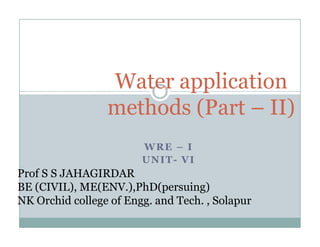
Water application methods (part – ii)
- 1. Water W t application li ti methods (Part – II) WRE – I UNIT- VI Prof P f S S JAHAGIRDAR BE (CIVIL), ME(ENV.),PhD(persuing) NK Orchid college of Engg and Tech , Solapur Engg. Tech.
- 3. 1] Drip irrigation Also known as trickle irrigation Drip irrigation refers to application of water i small li ti f t in ll quantity at the rate of mostly less than 12 Lit/hr as drops to the zone of the plants through a f h l h h network of plastic pipes fitted with emitters.
- 4. Components i) HEAD EQUIPMENTS a. Water source - Subsurface tank b f k b. Pump - Suction, monoblock pump, delivery non return valve, gate valve c. Filt station - S d filter, screen Filter t ti Sand filt filter, manifold and pressure gauge d. Fertiliser application - Fertiliser tank and ventury assembly
- 5. ii) DISTRIBUTION SYSTEM e. Conveyance line - Main line sub line, main, laterals, minor tubes and end caps. f. Drippers - P f D i Pressure corresponding di drippers. g. Valves - Non-return valve (NRV), Ball valves, valves Air release valve (ARV), flush (ARV) valves h. h Water meter - If necessary f
- 9. Sand filter Types of Filters SCREEN FILTER
- 10. Accessories
- 16. MERITS 1. Increased water use efficiency 2. Better crop yield 3. U if 3 Uniform and b tt quality of d better lit f the crops p 4. Efficient and economic use or fertilizer through fertigation 5. L Less weed growth d th
- 17. 6. Minimum damage to the soil structure 7 7. Avoidance of leaf burn due to saline soil 8. U 8 Usage i undulating areas and l in d l ti d less p permeable soil 9. Labour saving 10. High uniformity suitable for automization 11. No over irrigation
- 18. 11. Nutrients preservation p 12. No soil erosion 13. Suitable for any topography. 14. Increase in net irrigable area 15. Cultivation of cash crops l f h 16. Variation in application 6 V i ti i li ti rate. rate
- 19. DEMERITS 1. Clogging of d i l i f drippers 2. Ch i l precipitation Chemical i it ti 3. 3 Salt accumulation at wetting front
- 20. 1] Sprinkler irrigation In the sprinkler method of irrigation irrigation, water is sprayed into the air and allowed to f ll on the ground surface ll d fall h d f somewhat resembling rainfall. The g spray is developed by the flow of water under pressure through small orifices or nozzles. The pressure is usually obtained by pumping.
- 21. Advantages of sprinkler irrigation Elimination of the channels for conveyance, therefore no conveyance loss Suitable to all types of soil except heavy clay Suitable for irrigating crops where the plant population per unit area i very hi h It i most l ti it is high. is t suitable for oil seeds and vegetable crops Water saving Closer control of water application pp convenient for giving light and frequent irrigation and higher water application efficiency
- 22. Increase in yield Mobility of system May also be used for undulating area Saves land as no bunds etc. are required Areas located at a higher elevation than the source can be irrigated Possibility of using soluble fertilizers and chemicals Less problem of clogging of sprinkler nozzles due to sediment laden water
- 26. Traveling Volume Gun Sprinkler Irrigating from Lagoon g
- 27. Portable Solid-Set Sprinkler System Solid-
- 28. Fairway Runoff Research Plots at OSU Turf Research Farm
- 29. Side- Side-Roll Sprinkler Lateral in Peanuts
- 30. Center Pivot System with Spray Pad Sprinklers
- 31. Components (i) A pump unit (ii) Tubings - main/ sub mains and laterals l t l ( ) (iii) Couplers p (iv) Sprinkler head (v) O h ( ) Other accessories such as valves, i h l bends, plugs and risers.
- 36. Constraints in application of sprinkler irrigation (Demerits) (i) ( ) Uneven water distribution due to high winds. (ii) E Evaporation l ti loss when operating h ti under high temperatures. g p (iii) Highly impermeable soils are not suitable. it bl (iv) Initial cost is high.
- 37. No wind Elongated parallel pattern
- 38. (viii) More water requirement as compared to drip irrigation. d d i i i i (ix) High water pressure required in sprinkler (>2.5 kg/cm 2). (x) Difficulty in irrigation during wind in sprinkler . i di i kl
- 40. •Write detailed note on drip irrigation. Also draw layout of drip irrigation system showing different components. (Nov (N 2008 N 2007 8 marks, M 2007 N Nov 2007,8 k May Nov 2006 ,10 marks) •Write detailed note on Sprinkler method of irrigation. Also draw layout of sprinkler irrigation system showing different components. (May 2006 ,8 marks) •Draw and discuss layout of a drip irrigation system with its suitability suitability. (Nov 2009, 6 marks)
- 41. •Discuss the drip irrigation and sprinkler irrigation methods with their suitability suitability. (May 2009, 7 marks) •Discuss the sprinkler irrigation system in details with layout, advantages, limitations and suitability. (May 2010, (M 2010 7 marks) k) •Discuss the sprinkler irrigation system in p g y details with their advantages and disadvantages. disadvantages (Nov 2010, 8 marks)
